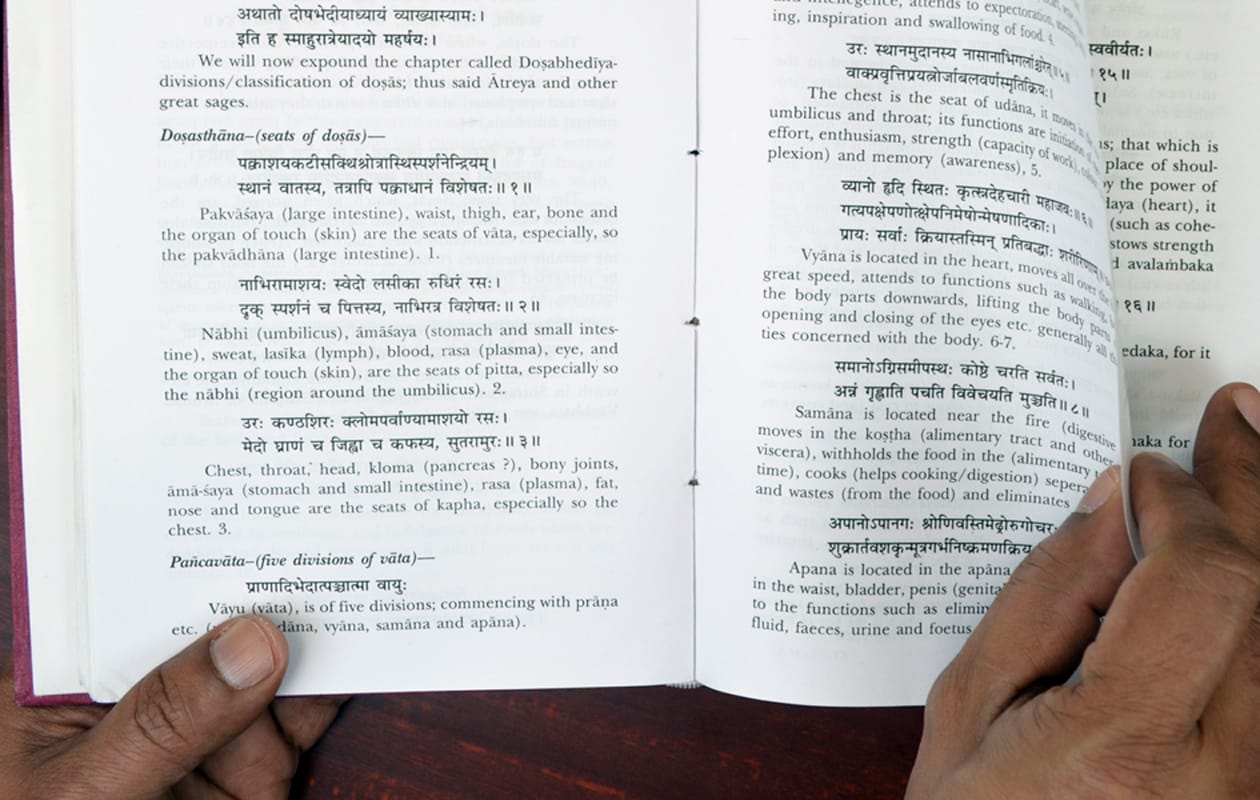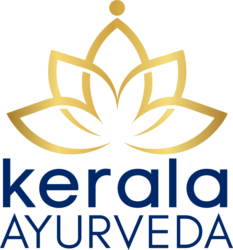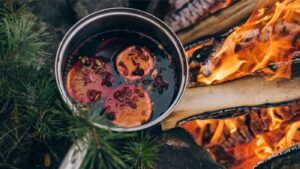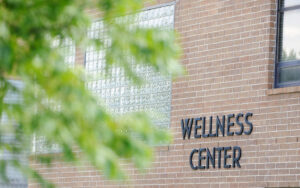As an Ayurvedic enthusiast, have you ever wondered what the root texts of this ancient health science actually say? Do you wish to learn straight from the source and hear the Ayurvedic principles in their native Sanskrit?
Kerala Ayurveda Academy offers you this opportunity in our live streamed Ashtanga Hridayam series! To give you an example of what you can learn from the ancient text, we’re going behind the sloka in this article with some insight on the heat therapy.
Ayurveda states that the combined synergy and equilibrium of mind, body, and soul is the key to ultimate health and happiness. The subtle energy channels (Srotas) in our body are often blocked by metabolic toxins, called Ama, as a result of weak digestive strength or Agni. This leads to clogging of Srotas and disruption of tissue nutrition, weakening the immune system, and causing health issues. Vedic texts like the Ashtanga Hridayam focus on understanding the subtle changes in the body to identify and rekindle Agni and cleanse Ama, before the imbalance emerges as illness. This can be achieved through Panchakarma – Ayurveda’s unique mind-body purification system. Many of the fads practiced nowadays to cleanse the body are not customized and may thus lead to improper effect and can be debilitating. The Ayurvedic approach, on the other hand, is personalized, does not focus merely on diagnostic tools, but rather on the awareness and sensitivity of the individual with his body and is designed with a detailed preparatory and a rejuvenatory phase to support a safe and effective cleansing.
Eliminating Ama by Ayurvedic detoxification methods
Understanding the cause of accumulation of digestive toxins and emotional clutter, as well as ways to eliminate them, forms one of the most basic strategies in Ayurveda to improve health and positive well-being of mind, body and spirit. The mode of cleansing and elimination is highly customized and has to be devised keeping in mind the physical and emotional state of the individual. Some of the detoxification methods are straight-forward, like intake of internal medicines; others might require a more complex cleansing, like utilizing Panchakarma: the five cleansing actions. Panchakarma eliminates deep-seated metabolic toxins which are the root cause of illness.
Panchakarma offers many therapies and techniques to address the uniqueness of each individual and scenario. Svedana, or heat therapy, is one of them, and can be used in two primary ways: (1) as a single detoxification therapy, in case there is only mild accumulation of Ama, or (2) as a preparatory step in a longer Panchakarma program, to facilitate the movement metabolic wastes for later elimination using other cleansing therapies. The mode and duration of Svedana therapy will depend on the psychosomatic constitution or Prakriti and strength of the individual, season, and therapeutic benefit intended.
Svedana can be beneficial when used in the right way, for the right person at the right time. It is not always beneficial. The following passage from the revered Ayurvedic text, Ashtanga Hridayam, states the contraindications of Svedana or fomentation therapy:
Na svedayet ati-sthoola-ruksha-durbala-moorchitaan |
Stambhaneeya-kshata-ksheena-visha-madyavikarinah ||
Timira-udara-visarpa-kushta-sopha-adyaroginah |
Peeth-dugdha-dadhi-sneha-madhoon krita-virechanaan ||
Brasht-dagdha-guda-glaani-krodha-shoka-bhayaardithaan |
Kshut-trishna-kamla-paandu-mehinah pitta-peedithaan ||
Garbhinim pushpithaam suthaam mridu cha aatyayike gade |
—As.Hri.Su 17/21-24
The above verses explain in a very condensed manner that Svedana, although very efficient in removing metabolic wastes from the body, is better avoided in certain conditions like:
- Those with improper fat metabolism
- Those with body fluid imbalances and those who are weak
- In a person who is experiencing light headedness or those who have consumed contaminated food or fermented beverages
- In those with dull eyesight or are injured as it may lead to further weakening of the body
- In an individual suffering from accumulation of fluid in the body, infections, skin issues, bloating, stiffening of thighs, or those who have consumed milk or curd, fats and honey
- Those who have undergone elimination therapies, who have weakened control over bowel movement, or in whom cautery is done are unfit for Svedana.
- Svedana is also contraindicated in low mood imbalances, anger, sorrow, and fear, in those who are starved or thirsty.
In diseases related to Pitta vitiation, impacted liver health, poor iron absorption in blood, and abnormal blood glucose levels, Svedana should not be performed as heat will aggravate these conditions. In women who are pregnant, it is unfavorable for the fetus. It is also contraindicated for women postpartum and during menstruation, as it may lead to excessive bleeding.
If Svedana has to be employed in such conditions, due to the gravity of the situation, subdued methods can be used.

What study of the slokas offers to your Ayurvedic practice
The appropriate knowledge about applying the right therapy at the right time will have tremendous results, and gaining this knowledge and skill is the foundation of Ayurvedic healing. Therapies have to be customized after assessing the individual and considering precautions, do’s and don’ts, pre and aftercare, as well as management of complications if you encounter any. All of this knowledge is documented in the Vedas, though the text alone does not contain the wisdom. It is the unbroken tradition of practicing Ayurvedic Doctors, or Vaidyas, who bring the slokas to life with their expert clinical guidance, allowing the Vedic texts’ detailed translations and insight to be understood.
The Ashtanga Hridayam is the “Heart or Essence” of Ayurvedic philosophy and healing, with clear guidelines about the right way to lead life. Written in beautiful lyrical Sanskrit verses, Ashtanga Hridayam is a condensed manual for contemporary Ayurvedic healers around the world, providing unparalleled benefit in their clinical practice, as the rhythmic recitation is easier for recollection. A lot of meaning is packed into the verses of the Ashtanga Hridayam, so while translations are available, the text alone does not provide enough information for a practitioner-in-training. Expert guidance is paramount to integrating the value of the verse.
The value of Ayurveda’s cleansing wisdom
Ayurveda focuses greatly on the holistic cleansing of the body to get rid of accumulated toxins which are even more relevant today, because of our faulty lifestyle and contamination of water and air, when we often feel worn out and unusually emotional. Committing to the Ayurvedic lifestyle and cleansing procedures is the best way to revamp our health to promote a more comprehensive way of living and feeling refreshed and strengthened.
Understanding the right methods to implement the knowledge of Ayurveda can be a game changer in your path to be a healer and to be healthy. With the amount of stress we have to endure in our life today with increased pollution, a whole-body cleanse has to be included in our routine to support our metabolic function and wellness. As you delve into a deeper understanding and involvement about the potent Ayurvedic cleansing methods and its rewards, you will find yourself more attuned to your inner self, with a newfound strength. This is the secret benefit of studying the Sanskrit verse. It is truly a mind, body, spirit experience!
Studying the Ashtanga Hridayam with us
Kerala Ayurveda Academy crafted a program extracting the quintessence principles of Ashtanga Hridayam. Learning authentic teachings of the ancient Vedic texts from an expert will help you unravel the depth of the concise slokas. You will be guided through the Ashtanga Hridayam by Vaidya. Jayarajan Kodikannath (BSc, BAMS), who will illuminate the deepest aspects of the Ayurvedic principles in simplified language. Chanting the Sanskrit slokas together, the vibrant richness of the beautiful ancient verses with the healing vibrations of Ayurveda will be a blissful spiritual experience for you that will leave you energized!
The next segment of our Ashtanga Hridayam series will cover chapters 17, 18 and 19 of the text, with the clinical applications, precautions, indications, and contraindications for Panchakarma detoxification procedures including Svedana (sudation), Vamana (emesis therapy), Virechana (purgation therapy) and Vasti (enema therapies).





